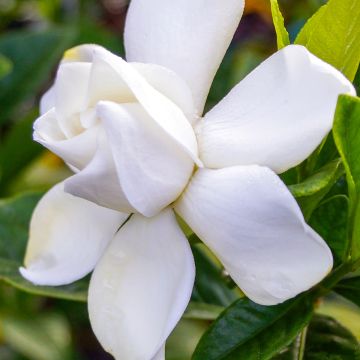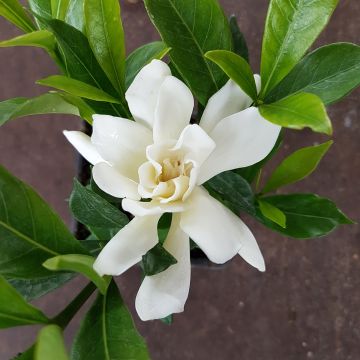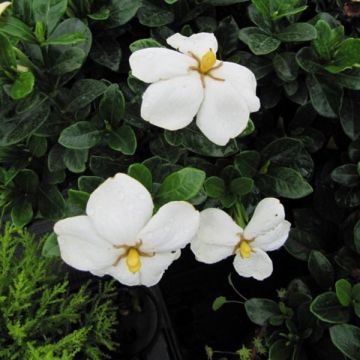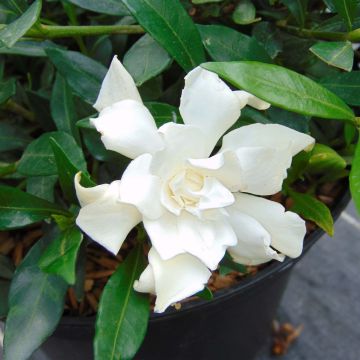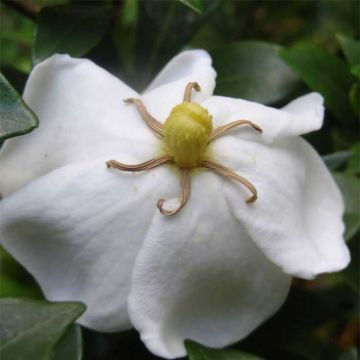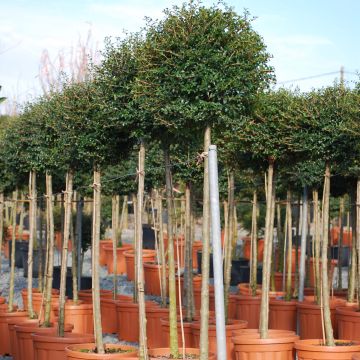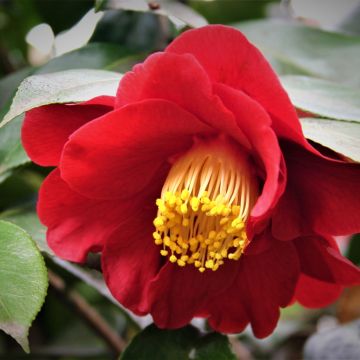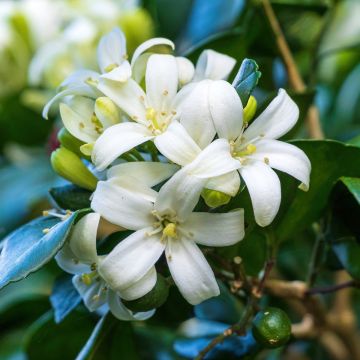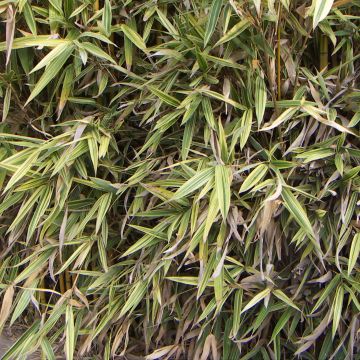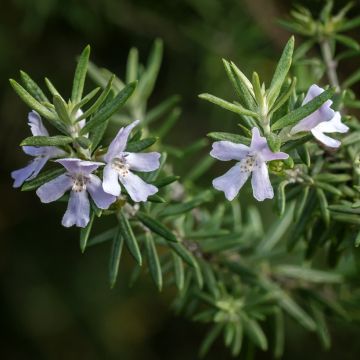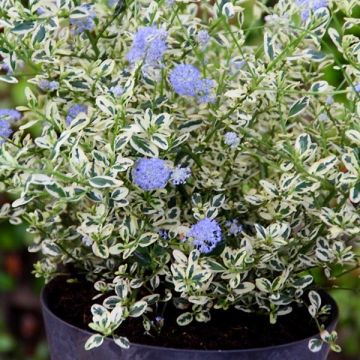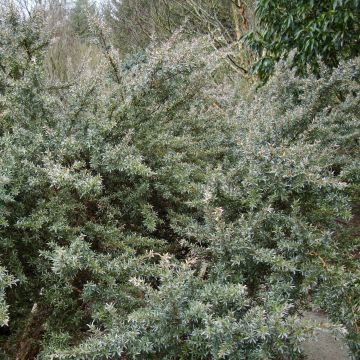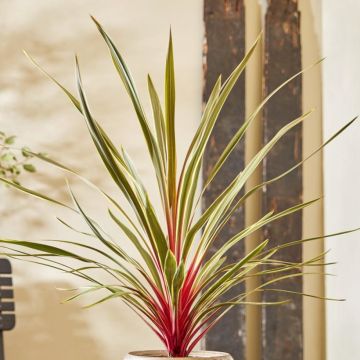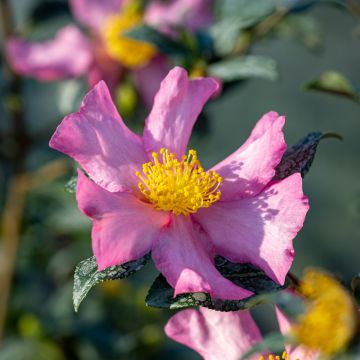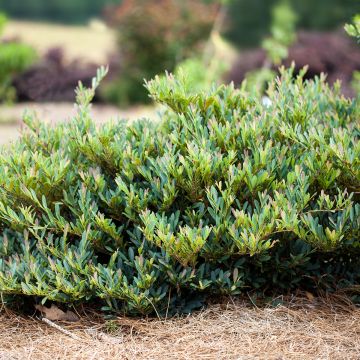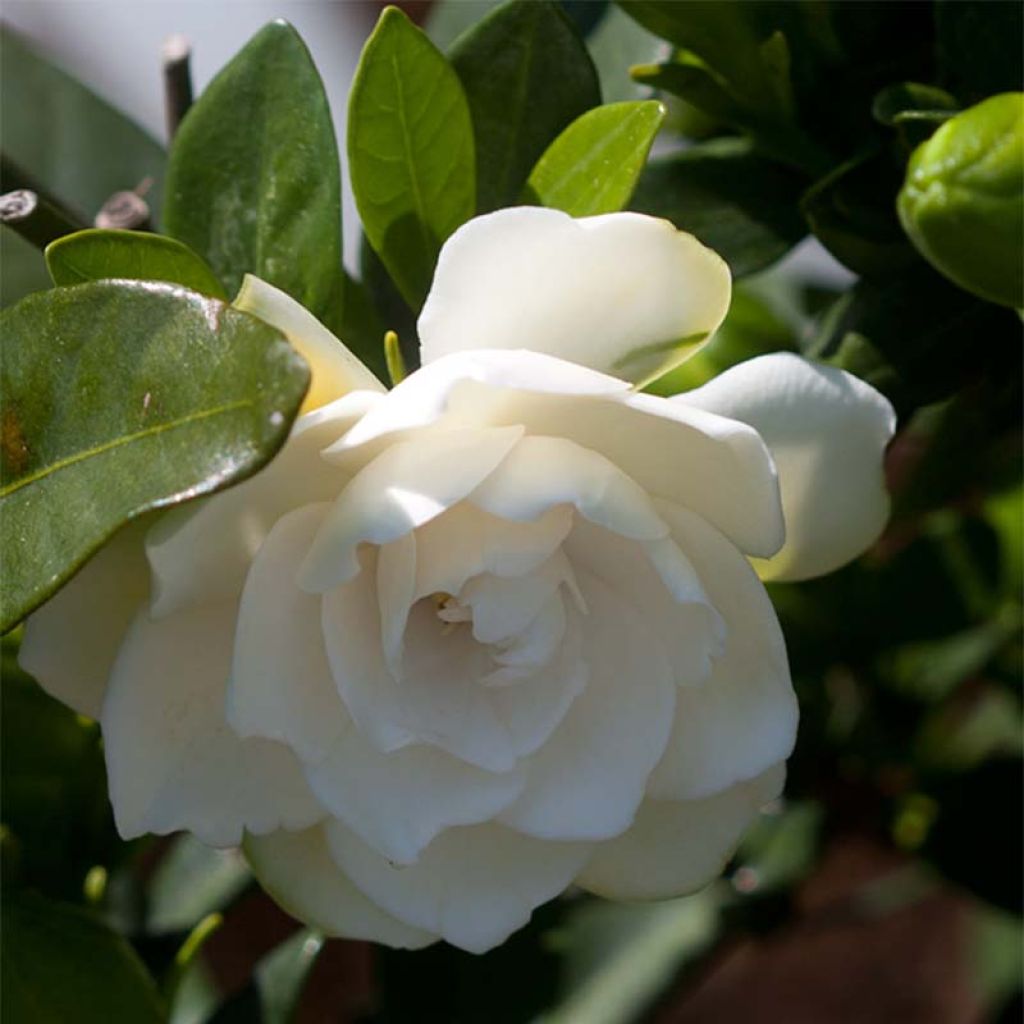

Gardenia jasminoides Double Mint
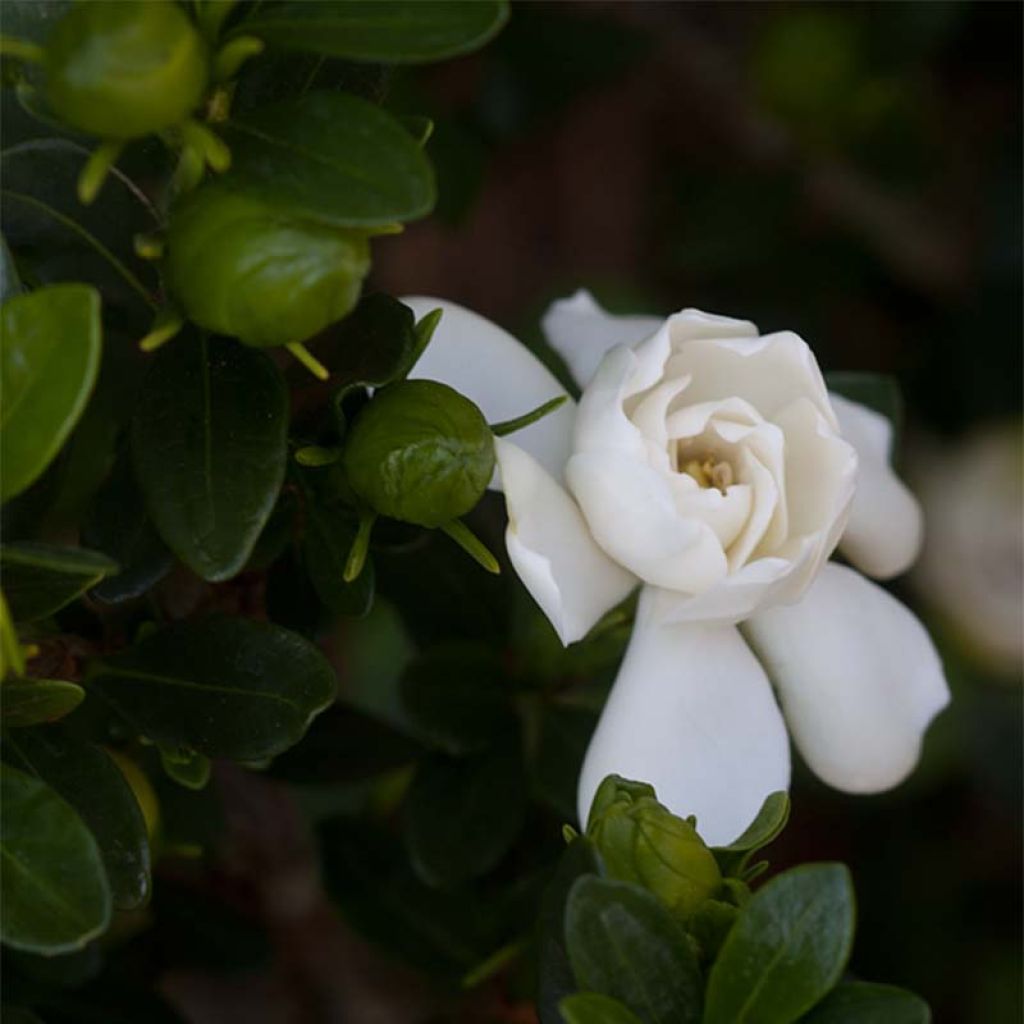

Gardenia jasminoides Double Mint
Gardenia jasminoides Double Mint
Gardenia jasminoides Double Mint
Cape Jasmine, Common Gardenia
This item cannot be shipped to the selected country
Delivery charge from €5.90
More information
Schedule delivery date,
and select date in basket
This plant carries a 24 months recovery warranty
More information
We guarantee the quality of our plants for a full growing cycle, and will replace at our expense any plant that fails to recover under normal climatic and planting conditions.
From €5.90 for pickup delivery and €6.90 for home delivery
Express home delivery from €8.90.
Does this plant fit my garden?
Set up your Plantfit profile →
Description
Gardenia jasminoides Double Mint, recently obtained in the USA, is an outdoor hardy gardenia, suitable for zone 7, which stands out for its long flowering period and compact habit. This attractive shrub can be grown in the open ground in many regions, but exclusively in slightly acidic, fertile and moist soil. This variety is more resistant to certain root diseases and has glossy foliage that retains its beautiful dark green color even in winter. Its double white flowers with a sweet fragrance bloom from spring to summer. It is an exceptional plant that deserves a prominent place in a pot on the terrace or near the house.
Gardenia jasminoides is a shrub of the Rubiaceae family, native to Asia. It is frequently found in the wild in Vietnam, southern China, Taiwan, Japan, and India, in mild and humid, subtropical to tropical climates. Its cultivation in China dates back to at least a thousand years, and in recent years numerous American cultivars have been produced, some hardier than others.
'Double Mint', obtained in 2012 in the state of Georgia in the USA, is the result of crossing Gardenia 'Chuck Hayes' with an unknown variety, as part of a breeding program targeting perpetual flowering varieties. It stands out from other hardy cultivars due to its long flowering period, compact and bushy habit, resistance to root rot, and smaller leaves. It slowly forms an adorable shrub with a rounded, bushy habit, reaching about 70 cm (27.6 in) in all directions in pots under good conditions, slightly more in the open ground. Its 5 cm (2 in) diameter double white flowers, with a waxy texture, abundant from May to June, and sporadically until November, fade to a creamy yellow colour. Their fragrance is powerful, sweet, delightfully intoxicating, addictive. They appear solitary in the axils of the leaves, at the top of the branches, retaining their cream-white colour for two days before fading to a pale yellow. Each flower is composed of 6 to 8 true petals and 16 to 18 petal-like sepals. They contrast well with its shiny dark green leaves, about 4.2 cm (1.7 in) long and 1.7 cm (0.7 in) wide. The leaves are entire, thick, leathery, with very prominent veins. Its bark is grayish. Gardenias have a very long lifespan and are generally more floriferous in their youth.
Despite their somewhat demanding nature, Gardenias are among the most coveted shrubs by plant enthusiasts. It is undeniable that when the right conditions are met, the gardenia proves to be one of the most beautiful plants in the garden. However, the hardiness of certain varieties like Double Mint, which is proven in the open ground down to at least -12 °C (10.4 °F), represents an achievement in horticultural research. This hardiness should be moderated depending on the duration of freezing temperatures, exposure to dry and cold winds, and soil moisture content. It is possible to successfully cultivate Gardenia Double Mint in the open ground, in a sheltered location and in non-calcareous soil. It also grows very well in pots, where it can withstand mild winters without damage. It is often preferable, outside of privileged regions, to move it to a cold greenhouse during winter as a precaution. In the garden, camellias, rhododendrons, pieris, and kalmias will make excellent companions for this wonderful shrub.
Report an error about the product description
Gardenia jasminoides Double Mint in pictures
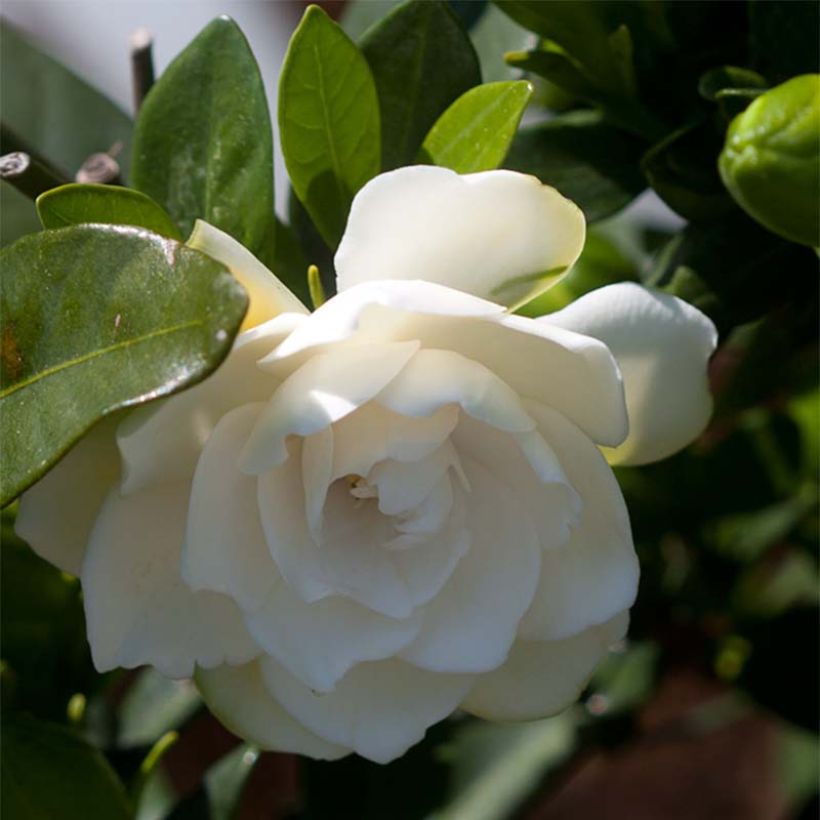

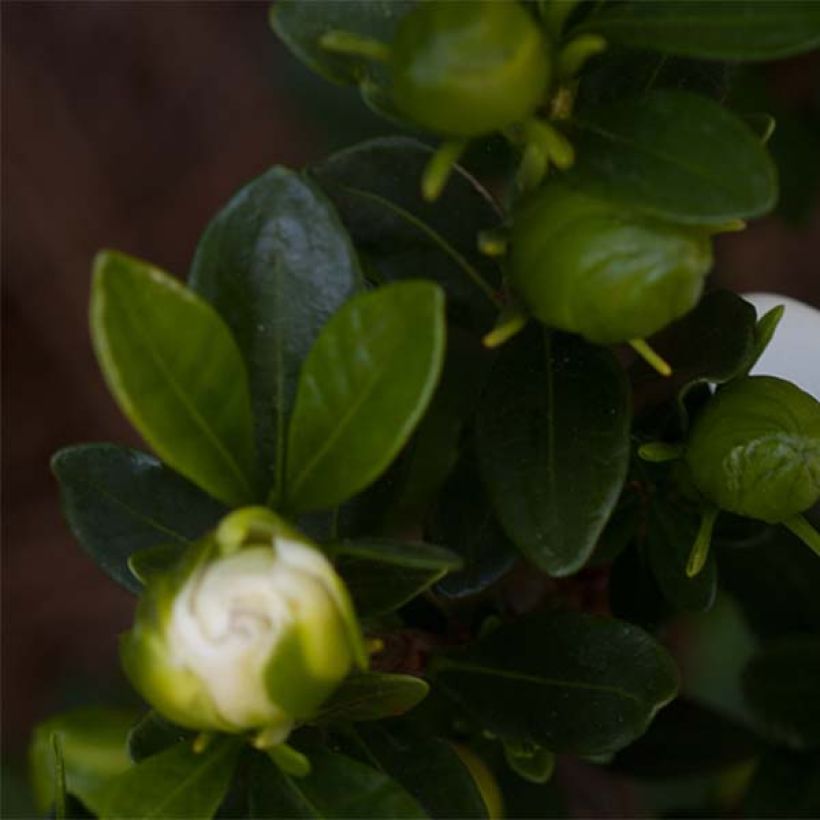

Plant habit
Flowering
Foliage
Botanical data
Gardenia
jasminoides
Double Mint
Rubiaceae
Cape Jasmine, Common Gardenia
Cultivar or hybrid
Other Gardenia
Planting and care
Plant Gardenia jasminoides Double Mint in a shaded border or in a spot exposed to morning sun, sheltered from the hottest rays of the sun. The exposure is important, as the Gardenia loves heat (but much less dry soil or air) and the harsh rays of the sun can scorch its foliage and flower buds. To improve its hardiness by a few degrees, plant it sheltered from cold and dry winds, make sure there is no stagnant moisture at its base in winter. On the other hand, it will need a good supply of non-calcareous water, especially during summer, during its establishment period. Therefore, choose a well-draining substrate, rich in humus, for example a mixture of potting soil and crumbly garden soil, lightened with non-calcareous sand, coarse gravel or clay pebbles. Whether you are in an area with mild winters or not, it is wise to protect container-grown plants in an unheated conservatory or a cold greenhouse. Gardenias also require regular fertilisation: use a specific fertiliser for acid-loving shrubs.
If your watering water is hard, add a teaspoon of chelating treatments diluted in a watering can every month during the growing season and regularly fertilise your gardenia with compost and fertiliser for acid-loving shrubs. This method seems to succeed for some gardeners who cultivate huge pots of gardenias on semi-shaded terraces. A method that requires a lot of effort and attention but seems to bear fruit.
Planting period
Intended location
Care
-
, onOrder confirmed
Reply from on Promesse de fleurs
Evergreen shrubs
Haven't found what you were looking for?
Hardiness is the lowest winter temperature a plant can endure without suffering serious damage or even dying. However, hardiness is affected by location (a sheltered area, such as a patio), protection (winter cover) and soil type (hardiness is improved by well-drained soil).

Photo Sharing Terms & Conditions
In order to encourage gardeners to interact and share their experiences, Promesse de fleurs offers various media enabling content to be uploaded onto its Site - in particular via the ‘Photo sharing’ module.
The User agrees to refrain from:
- Posting any content that is illegal, prejudicial, insulting, racist, inciteful to hatred, revisionist, contrary to public decency, that infringes on privacy or on the privacy rights of third parties, in particular the publicity rights of persons and goods, intellectual property rights, or the right to privacy.
- Submitting content on behalf of a third party;
- Impersonate the identity of a third party and/or publish any personal information about a third party;
In general, the User undertakes to refrain from any unethical behaviour.
All Content (in particular text, comments, files, images, photos, videos, creative works, etc.), which may be subject to property or intellectual property rights, image or other private rights, shall remain the property of the User, subject to the limited rights granted by the terms of the licence granted by Promesse de fleurs as stated below. Users are at liberty to publish or not to publish such Content on the Site, notably via the ‘Photo Sharing’ facility, and accept that this Content shall be made public and freely accessible, notably on the Internet.
Users further acknowledge, undertake to have ,and guarantee that they hold all necessary rights and permissions to publish such material on the Site, in particular with regard to the legislation in force pertaining to any privacy, property, intellectual property, image, or contractual rights, or rights of any other nature. By publishing such Content on the Site, Users acknowledge accepting full liability as publishers of the Content within the meaning of the law, and grant Promesse de fleurs, free of charge, an inclusive, worldwide licence for the said Content for the entire duration of its publication, including all reproduction, representation, up/downloading, displaying, performing, transmission, and storage rights.
Users also grant permission for their name to be linked to the Content and accept that this link may not always be made available.
By engaging in posting material, Users consent to their Content becoming automatically accessible on the Internet, in particular on other sites and/or blogs and/or web pages of the Promesse de fleurs site, including in particular social pages and the Promesse de fleurs catalogue.
Users may secure the removal of entrusted content free of charge by issuing a simple request via our contact form.
The flowering period indicated on our website applies to countries and regions located in USDA zone 8 (France, the United Kingdom, Ireland, the Netherlands, etc.)
It will vary according to where you live:
- In zones 9 to 10 (Italy, Spain, Greece, etc.), flowering will occur about 2 to 4 weeks earlier.
- In zones 6 to 7 (Germany, Poland, Slovenia, and lower mountainous regions), flowering will be delayed by 2 to 3 weeks.
- In zone 5 (Central Europe, Scandinavia), blooming will be delayed by 3 to 5 weeks.
In temperate climates, pruning of spring-flowering shrubs (forsythia, spireas, etc.) should be done just after flowering.
Pruning of summer-flowering shrubs (Indian Lilac, Perovskia, etc.) can be done in winter or spring.
In cold regions as well as with frost-sensitive plants, avoid pruning too early when severe frosts may still occur.
The planting period indicated on our website applies to countries and regions located in USDA zone 8 (France, United Kingdom, Ireland, Netherlands).
It will vary according to where you live:
- In Mediterranean zones (Marseille, Madrid, Milan, etc.), autumn and winter are the best planting periods.
- In continental zones (Strasbourg, Munich, Vienna, etc.), delay planting by 2 to 3 weeks in spring and bring it forward by 2 to 4 weeks in autumn.
- In mountainous regions (the Alps, Pyrenees, Carpathians, etc.), it is best to plant in late spring (May-June) or late summer (August-September).
The harvesting period indicated on our website applies to countries and regions in USDA zone 8 (France, England, Ireland, the Netherlands).
In colder areas (Scandinavia, Poland, Austria...) fruit and vegetable harvests are likely to be delayed by 3-4 weeks.
In warmer areas (Italy, Spain, Greece, etc.), harvesting will probably take place earlier, depending on weather conditions.
The sowing periods indicated on our website apply to countries and regions within USDA Zone 8 (France, UK, Ireland, Netherlands).
In colder areas (Scandinavia, Poland, Austria...), delay any outdoor sowing by 3-4 weeks, or sow under glass.
In warmer climes (Italy, Spain, Greece, etc.), bring outdoor sowing forward by a few weeks.

































